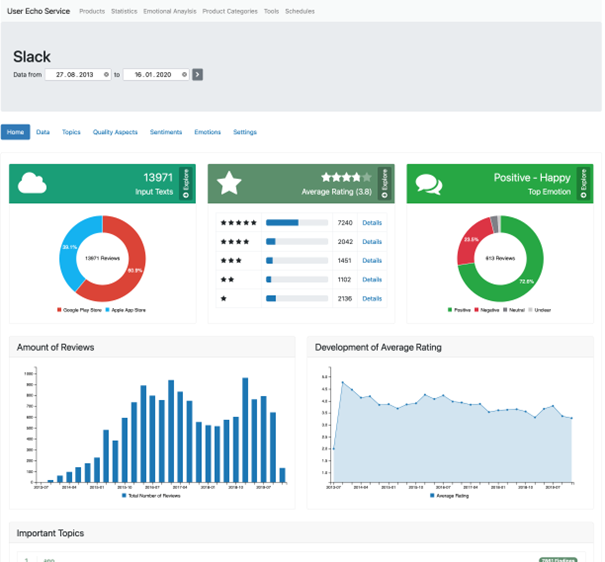Do you want to get to know and analyze in more detail how users feel about your software product or a competitor’s product? Is your product suddenly unpopular? Or are you wondering what users want? Then we at Fraunhofer IESE are the right partner at your side with our “User Echo Service”.
»User Echo Service«
Automation in product development
Listen to your users with “User Echo Service”
The high market pressure, the variety of different devices, and the often limited resources are challenging for the development of software products. Users, on the other hand, demand high quality and uninstall software products immediately if they do not meet their needs.
App stores, gaming platforms, web stores, and queries built into apps allow users to provide feedback on products that can also be viewed by others. At the same time, the use of social media and the dissemination of personal opinions have become a phenomenon for society as a whole. Feedback is an important factor for the success of a product.
“User Echo Service” makes it possible to systematically collect and evaluate feedback from various data sources. This allows you to analyze user sentiment towards a product. This is not only applicable to your own app, but also to the analysis of competitor products. Private data sources can also be tapped into, such as feedback that comes directly from an application or is supplied by customer support. This allows trends in user sentiment to be identified, new desired functions and improvements to be derived, and the severity of problems to be assessed.
We provide you with “User Echo Service” as a simple and convenient web-based dashboard. The key feature of “User Echo Service” is that feedback is viewed as a continuum and that the database is constantly growing. Our AI-supported processing enables you to continuously identify current trends in the data. This allows you to reliably learn from the past in order to develop even better products.

»User Echo Service« im Überblick
Goals
- Understanding user feedback on a software product
- Gaining insights into users’ wishes and ideas
- Identifying an app’s improvement potential
- Understanding the strengths and weaknesses of competitor products
- Long-term successful software products with high user satisfaction
Method
- Determination of the apps and data sources to be analyzed
- Definition of the data provision interval (every week, every two weeks, or monthly) at which new feedback is imported
- Optional: Support for connecting the User Echo Service API for private data sources
- Provision of User Echo Service as a ready-to-use Software-as-a-Service offering and provision of the feedback at the selected interval
- Extended all-around worry-free offering: Periodic analysis of the feedback by Fraunhofer IESE with derivation of recommendations for action to improve your software product
Results
- Analyzed user feedback in the web-based dashboard of the User Echo Service
- Transparent graphical drill-down from a general overview of the feedback to individual user statements
- Identification of potentials and problems that even a sophisticated user research and quality assurance process has overlooked for years, and thus demonstrably better products
Your benefits
- You always have an overview of current user feedback on the product so that you know what users think.
- You receive AI-based support in making decisions on product features through the automated evaluation of large amounts of data.
- You can perform a deep dive in the data and explore specific areas of the application in more detail so that you can make well-informed decisions on functionalities and further developments.
- By constantly keeping an eye on the feedback, you can continuously monitor in which areas the product is performing well or poorly, identify trends, and thus make strategic decisions about your product based on data.